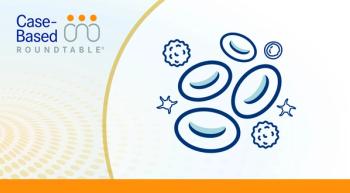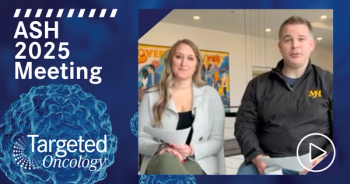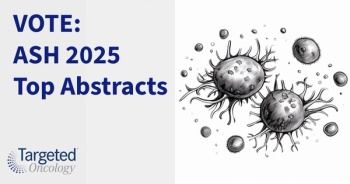
Eltrombopag Boosts Responses in Severe Aplastic Anemia
Over one-third of patients with severe aplastic anemia has hematologic responses lasting at least 6 months when the oral thrombopoietin inhibitor eltrombopag was added to conventional immunosuppressive therapy, according to data from a prospective single-center phase II trial presented at the 57th ASH meeting.
Danielle Townsley, MD
Over one-third of patients with severe aplastic anemia has hematologic responses lasting at least 6 months when the oral thrombopoietin inhibitor eltrombopag was added to conventional immunosuppressive therapy, according to data from a prospective single-center phase II trial presented at the 57th ASH meeting.
The rate of complete hematologic response was 28% at 3 months and 37% at 6 months among the 92 patients who received eltrombopag alongside equine antithymocyte globulin (ATG) and cyclosporine. The overall response rate was 81% at 3 months and 86% at 6 months.
Both outcomes exceeded historical response rates with conventional therapy, with the best results occurring when eltrombopag was administered concurrently with immunosuppressive agents, said Danielle Townsley, MD, staff physician, National Heart, Lung, and Blood Institute.1
“Immediate introduction of eltrombopag with immunosuppressive therapy may be optimal,” she said. “Eltrombopag is associated with increased CD34-positive cells, robust neutrophil and platelet-count recovery, and transfusion independence within 1 to 2 months. Longer follow-up is required to assess the rate of clonal evolution.”
About two thirds of patients with severe aplastic anemia achieve some degree of hematologic response with conventional immunosuppressive therapy, most often the combination of ATG and cyclosporine. However, response rates have been stable for three decades despite ongoing efforts to improve outcomes in the condition.
The FDA has approved eltrombopag for refractory severe aplastic anemia. In pivotal studies, eltrombopag demonstrated single-agent activity in about 40% of patients enrolled in two studies of refractory severe aplastic anemia, with the second trial demonstrating bi- and trilineage responses.2,3
“The latter study showed trilineage improvement, meaning that not just platelets improved but also neutrophils and red cells,” she said.
A logical next step for eltrombopag was evaluation of the agent in combination with standard treatment in patients with previously untreated severe aplastic anemia, Townsley noted. Investigators theorized that the eltrombopag combination might increase the response rate, and accelerate cell count recovery, prevent hematopoietic stem cell depletion, and at the same time avoid clonal progression.
In the phase II study, the eltrombopag combination was examined in three cohorts of patients with untreated severe aplastic anemia enrolled from July 2012 to October 2015. All patients received standard treatment with ATG and cyclosporine.
The first cohort received eltrombopag starting on day 14 and continuing for 6 months (30 patients). The second cohort received the thrombopoietin inhibitor from day 14 through 3 months to address concerns about potential hepatotoxicity (N=31). In the third group, eltrombopag was initiated concurrently on day 1 with conventional immunosuppressive therapy and continued for 6 months.
Previous trials of immunosuppressive therapy had shown that complete hematologic response correlated with better survival and a reduced risk of evolution myelodysplastic syndrome. As a result, investigators chose complete response as the primary endpoint of the trial.
The primary analysis showed complete response rates at 3 months of 17% (five of 30) in the first cohort, 26% (eight of 31) in the second cohort, and 44% (11 of 25 evaluable patients) in the third cohort. Overall, 24 of 92 patients (28%) achieved complete response.
Complete response rates at 6 months were 33% in the first cohort, 26% in the second, and 60% (12 of 20 evaluable patients), resulting in an overall complete response rate of 37% across the three cohorts.
The 3-month overall response rates ranged from 77% to 92% across the three cohorts, and 6-month response rates ranged from 80% to 95%.
The highest rates of complete and overall response occurred in the third cohort of patients who received eltrombopag concurrently with ATG and cyclosporine.
The trial resulted in relatively few grade 3/4 eltrombopag-associated adverse events. Two patients developed severe cutaneous reactions and discontinued the drug. About 10% of the total study population developed grade 2/3 transaminase or bilirubin elevations.
The only death during the trial resulted from a thymoma associated with paraneoplastic encephalopathy. Seven patients had clonal evolution.
References
- Townsley DM, Dumitriu B, Scheinberg P, et al. Eltrombopag added to standard immunosuppression for aplastic anemia accelerates count recovery and increases response rates. Presented at: 57th American Society of Hematology Annual Meeting; Orlando, Florida; December 5-8, 2015. Abstract LBA-2.
- Olnes MJ, Scheinberg P, Calvo KR, et al. Eltrombopag and improved hematopoiesis in refractory aplastic anemia. N Engl J Med. 2012;367:11-19.
- Desmond R, Townsley DM, Dumitriu B, et al. Eltrombopag restores trilineage hematopoiesis in refractory severe aplastic anemia that can be sustained on discontinuation of drug. Blood. 2014;123:1818-1825.









































